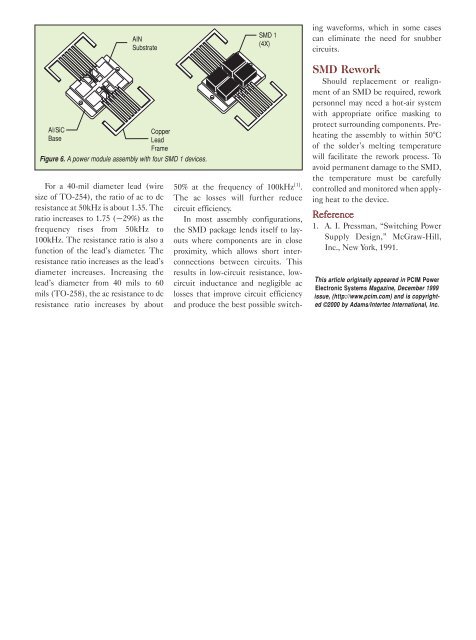New Materials and Technologies Solve Hermetic SMD Integration
New Materials and Technologies Solve Hermetic SMD Integration
New Materials and Technologies Solve Hermetic SMD Integration
You also want an ePaper? Increase the reach of your titles
YUMPU automatically turns print PDFs into web optimized ePapers that Google loves.
ing waveforms, which in some cases<br />
can eliminate the need for snubber<br />
circuits.<br />
Figure 6. A power module assembly with four <strong>SMD</strong> 1 devices.<br />
For a 40-mil diameter lead (wire<br />
size of TO-254), the ratio of ac to dc<br />
resistance at 50kHz is about 1.35. The<br />
ratio increases to 1.75 (~29%) as the<br />
frequency rises from 50kHz to<br />
100kHz. The resistance ratio is also a<br />
function of the lead’s diameter. The<br />
resistance ratio increases as the lead’s<br />
diameter increases. Increasing the<br />
lead’s diameter from 40 mils to 60<br />
mils (TO-258), the ac resistance to dc<br />
resistance ratio increases by about<br />
50% at the frequency of 100kHz [1] .<br />
The ac losses will further reduce<br />
circuit efficiency.<br />
In most assembly configurations,<br />
the <strong>SMD</strong> package lends itself to layouts<br />
where components are in close<br />
proximity, which allows short interconnections<br />
between circuits. This<br />
results in low-circuit resistance, lowcircuit<br />
inductance <strong>and</strong> negligible ac<br />
losses that improve circuit efficiency<br />
<strong>and</strong> produce the best possible switch-<br />
<strong>SMD</strong> Rework<br />
Should replacement or realignment<br />
of an <strong>SMD</strong> be required, rework<br />
personnel may need a hot-air system<br />
with appropriate orifice masking to<br />
protect surrounding components. Preheating<br />
the assembly to within 50°C<br />
of the solder’s melting temperature<br />
will facilitate the rework process. To<br />
avoid permanent damage to the <strong>SMD</strong>,<br />
the temperature must be carefully<br />
controlled <strong>and</strong> monitored when applying<br />
heat to the device.<br />
Reference<br />
1. A. I. Pressman, “Switching Power<br />
Supply Design,” McGraw-Hill,<br />
Inc., <strong>New</strong> York, 1991.<br />
This article originally appeared in PCIM Power<br />
Electronic Systems Magazine, December 1999<br />
issue, (http://www.pcim.com) <strong>and</strong> is copyrighted<br />
©2000 by Adams/Intertec International, Inc.
















